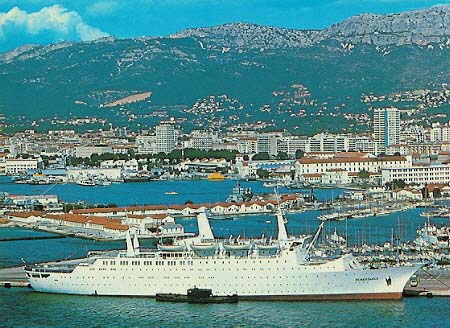We forget how far the travel industry has come in a relatively short time. Cruise ships floating around our seas today are more like a series of skyscrapers stacked onto a sprawling mall than a vessel to travel between Point A and Point B.
I found this advertisement in a 1977 newspaper for a simple luxury cruise down the Pacific Coast from Vancouver, British Columbia to Los Angeles, California. What’s amazing is that the departure date of September 24, 1977 just happens to be the date of the very first airing of the television series “The Love Boat”.
Although the current day cruise lines were in operation by this time with Princess Cruises founded in 1966, Royal Caribbean founded in 1968 and Carnival Cruises founded in 1972, it was “The Love Boat” that really spurred the cruise vacation industry. What an amazing coincidence that the M.S. Renaissance took off along the Pacific Coast on the same day people first tuned in for this ground-breaking television series about how taking a cruise can basically get you laid!
It was just a coincidence. The M.S. Renaissance of Paquet French Cruises was not one of the ships used in the television show. However, it did look very similar. And, what a deal! Just $289 (plus probably a ton of taxes) for three nights from Vancouver to Los Angeles and that included the return flight back to Vancouver on board Canadian Pacific Air (CP Air).
 M.S. Renaissance
M.S. Renaissance
The ship was built in 1966 and was tiny by today’s standards. At just 12,000 gross tonnage, the Renaissance was 492 feet long with a capacity for 474 passengers and 230 crew members. The cruise speed was just 16 knots.
In comparison, the Ruby Princess, a standard modern cruise ship – not the biggest and not the smallest – is 951 feet in length with a gross tonnage of 113,000. The Ruby has a passenger capacity of 3,080 and needs 1,200 crew members to operate. The Ruby Princess cruises along at 23 knots and is still not the fastest on the water.
The other thing about the M.S. Renaissance, as with mostly all cruise ships back in the day, is that there were no private balconies.
The vessel was built by Chantiers de L’Atlantique – still one of the leaders in cruise ship building today. Originally, the Renaissance was used as a ferry, taking passengers from Marseilles, France to Haifa, Israel while also providing cruise itineraries in the Eastern Mediterranean. For most of the 1970’s, she typically ran Trans Atlantic cruises from Marseilles to New York City.
After being bought and sold several times over the next few decades, the M.S. Renaissance was taken out of service in 2009 and scrapped in 2010.
 CP Air
CP Air
As for the airline these people would be taken back to Vancouver with, CP Air was founded in 1942 and ceased operations in 1987. During that time, it served as Canada’s second national airline, behind Air Canada. CP Air was bought and morphed into the ill-fated Canadian Airlines in 1988.







